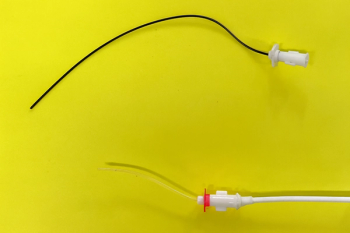
Diagnosing and managing urinary incontinence in dogs (Proceedings)
The causes of urinary incontinence classically are divided into neurogenic or non-neurogenic categories.
The causes of urinary incontinence classically are divided into neurogenic or non-neurogenic categories. Non-neurogenic causes are most common, and a thorough neurological examination is important in making this distinction. Another approach is to divide causes of incontinence into those associated with small to normal-sized bladder and those associated with an enlarged bladder at the time of the incontinence. Most cases of urinary incontinence (especially non-neurogenic causes) are associated with a small to normal-sized bladder at presentation.
It is also important to differentiate loss of voluntary control from behavioral changes or recent onset of polyuria and polydipsia. Previous response to (or lack of response to) antibiotics or anti-inflammatory drugs may suggest the nature of an underlying condition. It is helpful for diagnostic direction and assessment to characterize the animal's ability to initiate a urine stream, the diameter of the stream, any interruptions of the stream, and any apparent pain.
Primary sphincter mechanism incompetence (PSMI)
PSMI is the most common cause of urinary incontinence in adult female dogs seen in primary care practice. Incontinence in spayed female dogs previously was called hormone-responsive, or estrogen-responsive, incontinence. This occurs approximately 3 years after ovariohysterectomy in approximately 20% of female dogs neutered between their first and second heat cycles; in dogs spayed before their first estrus, the incidence is reported to be 9.7% (Stocklin-Gautschi 2001;57:233-6). PSMI may occur in any breed of dog or in mixed breed dogs but some breeds are over-represented including the Doberman pinscher, Giant Schnauzer, Old English Sheepdog, Rottweiler, and Boxer.
The German Shepherd and Dachshund are underrepresented in some reports of dogs with PSMI. PSMI is more common in large dogs (> 20 kg) in which the incidence of incontinence may be as high as 30%(Arnold S. Schweizer Archiv fur Tierheilkunde 1989). 5.1% of bitches in a recent reported were found to have spay-related urinary incontinence (Veronesi MC. Acta Vet Hung 2009). Bitches weighing more than 10 kg were nearly 4 times as likely to develop post-spay PSMI than those less than 10 kg (de Bleser B. Vet J 2011).
Urinary incontinence can occur before spaying in some breeds such as Greater Swiss Mountain dogs, Soft Coated Wheaten terriers, Dobermans and Giant Schnauzers. The main mechanism for the development of urinary incontinence with PSMI has traditionally been attributed to low urethral closure pressure, though some dogs have a bladder component to this form of urinary incontinence (Nickel RF Vet Rec 1999). Urethral closure pressure is decreased 12 to 18 months following spaying in normal dogs (Arnold S. Schweizer Archiv fur Tierheilkunde 1997; Salomon JF; Vet Record 2006) and it is speculated that this pressure continues to decline with age.
Phenylpropanolamine (PPA) is the initial treatment of choice to restore urinary continence in dogs with PSMI. Incontinence is controlled in 75-90% of female dogs with PSMI treated with the α-adrenergic agonist PPA at a dosage of 1.0-1.5 mg/kg PO q12h or q8h (standard preparation). PPA is also available as a sustained release product (Cystolamine®; 75 mg capsule). More than half of the dogs that failed to respond with the standard formulation of PPA became continent when treated with a sustained release formulation of this drug (Bacon NJ 2002). Once daily administration may be desirable for many owners. The recommended dosage of Cystolamine® is ½ capsule PO q24h for dogs < 18 kg, 1 capsule PO q24h for dogs 19-45 kg, and 1 ½ capsules PO q24h for dogs > 45 kg. MUCP is increased on the UPP after treatment with PPA.
Virtually all affected dogs have some improvement in continence after treatment with PPA. The largest dose should be given at night to control incontinence while the dog is sleeping. In dogs with incontinence only at night, dosing only at night can be effective. PPA may become less effective with prolonged use (so-called tachyphylaxis). Occasionally, simply increasing the dosage of PPA is sufficient to regain control of continence. Potential adverse effects include restlessness and hypertension.
Relative contraindications to use include known underlying cardiac disease, chronic kidney disease, or systemic hypertension. Although systemic hypertension did not develop after months of PPA exposure to young dogs in an experimental setting, we have observed client-owned dogs with PSMI on PPA that have developed systemic hypertension. We recommend systemic blood pressure be measured before beginning PPA treatment and periodically thereafter to identify the development of systemic hypertension.
Estrogens are an effective treatment for PSMI in many dogs and can be given much less frequently than PPA. Incontinence is controlled in 60-65% of affected dogs treated with estrogens alone for PSMI. Estrogen increases the sensitivity of urethral α-adrenergic receptors to catecholamines; they also may increase the number of receptors. The MUCP is increased on the UPP after treatment with estrogens.
Diethylstilbesterol (DES) is dosed at 0.1-1.0 mg (0.02 mg/kg) per dog PO for 3-5 days followed by 0.1-1.0 mg PO every 3 to 7 days. DES has become more difficult to obtain because it is no longer used in human patients but it is available from veterinary compounding pharmacies. Premarin® (conjugated estrogens - obtained from pregnant mare's urine) is dosed at 20 μg/kg PO q3d or q4d. This drug contains sodium estrone sulfate (50-65%), and sodium equilin sulfate (20-35%); estrone is converted to estradiol. Although published information on the use of Premarin® in dogs with PSMI is lacking, we have had success with this product in our hospital.
Oestriol (Incurin®; a naturally-occurring, short-acting estrogen) is dosed at 2 mg per day for 1 week followed by reduction to minimally effective daily dose (0.25 to 2.0 mg) and finally alternate day dosing (dose not related to body weight). 61% of treated dogs achieved continence and 22% improved for overall response rate of 83% with oestriol treatment; no hematologic abnormalities were identified. Potential complications of treatment with estrogens include induction of the clinical signs of estrus, perineal alopecia, and bone marrow suppression. We have not encountered bone marrow suppression in dogs receiving low dose intermittent estrogens; this is most often seen after use of long-acting injectable estrogens such as estradiol cypionate or with overdose.
Urethral bulking agents can be effective in the treatment of PSMI in humans and dogs. Successful implantation of urethral bulking agents avoids the need for daily medication. The bulking agent and implantation process are expensive and may not have long duration of effect in some dogs. Successful implantation requires special equipment and technical expertise. Medical grade Teflon® was used as the first urethral bulking agent in dogs but was soon replaced by gluteraldehyde treated bovine cross-linked collagen (Contigen®; Bard).
Submucosal urethral collagen injections improve continence in most dogs that have failed PPA treatment for PSMI. The goal is to create cystoscopically-visible 360° apposition of the urethral mucosa by submucosal implantation of collagen at 3 sites: the 12 o'clock position (0°), 4 o'clock position (120°), and 8 o'clock position (240°) approximately 1 to 1.5 cm caudal to the vesicourethral junction. A 50-80% response rate with collagen alone as treatment is reported. Collagen injections often render PPA more effective than prior to collagen injections in dogs not completely continent after collagen injections.
In one study, collagen injections controlled incontinence in 27/40 dogs treated for an average of 17 months (range, 1-64 months). A recent study using collagen for urethral bulking involved 21 female dogs with PSMI and 10 with ectopic ureter (Byron JK JVIM 2011). Dogs of this study had a significant increase in continence score after the procedure. Mean (SD) duration of continence in dogs without addition of medication was 16.4 (15.2) months, and 5.2 (4.3) months in dogs needing additional medical therapy. The degree of coaptation of the urethra following the bulking procedure was not related to continence scores. Since the long-term success of collagen implantation is not related to the degree of urethral coaptation, it may be related to an increased force of sphincter muscle contraction secondary to stretching of the sarcomere following the bulking agent implantation; vascular smooth muscle and striated muscle are known to exert increased contractile force when stretched (Byron JVIM 2011). Client satisfaction was excellent despite a variable duration and degree of improvement of the urinary incontinence.
The duration of improvement following collagen implantation is variable and there are no identified factors that will predict the degree or duration of improvement in any individual dog. Five dogs in this study had a second series of collagen injections. Often these injections are placed into the previous injection sites to augment the degree of urethral coaptation. Loss of the beneficial effect following collagen implantation occurs in some dogs possibly due to loss of volume as absorption of the phosphate buffer occurs; occasionally there is complete loss of the implanted collagen into the urethral lumen.
There are a variety of other urethral bulking agents that have been used in human medicine but none have been reported in the veterinary literature– collagen has been the most commonly used agent in dogs. Contigen® (Bard) has been the gold standard for urethral bulking in veterinary medicine for a long time, but Bard stopped manufacturing this product in 2011.
RegGain® (Avalon Medical; Stillwater, MN) was formulated for veterinary use as a direct replacement for Contigen®. This preparation was previously available only in a research formulation but will begin marketing as a fully available retail product in October 2011. ReGain® contains a higher concentration of collagen in suspension compared to the Bard product (42 mg/ml vs 35 mg/ml ); this could mean more bulking per ml of suspension delivered to the urethral submucosa. ReGain® does not require refrigeration as did Contigen® and the company claims to have improved the collagen crosslinking technology compared to Contigen.
Use of this formulation of collagen has yet to be reported in veterinary medicine. ReGain® is substantially less expensive than the human product ($250 for 2.5 ml in a prefilled syringe). Researchers at the University of Tennessee are currently in the process of evaluating polydimethylsiloxane (PDMS; Macroplastique® -Uroplasty, Inc Minnetonka, MN) in a clinical study of female dogs with PSMI. This product has used to treat European women with stress induced urinary incontinence since 1991 and was FDA approved for use in the USA in 2006. PDMS outperforms collagen urethral bulking in studies of humans with urinary incontinence. In an interim report on 22 dogs with PSMI, 17 were fully continent without other medications and 3 were improved 1 month following urethral implantation with PDMS.
Three dogs experienced blepharedema and urticarial as an allergic reaction attributed to the PVP gel component of the PDMS injection– all responded to antihistamine treatment; one dog experienced transient urethral obstruction that required an indwelling urethral catheter (Bartges JW; JVIM 2011). Longer-term outcome scores for urinary incontinence will be reported at the conclusion of this 2-year study. It has yet to be determined whether PDMS will be marketed to veterinarians.
We recommend urethral bulking treatment over standard surgeries in most dogs. The recent development of a urethral hydraulic occluder (artificial urethral sphincter - AUS) is a much less invasive surgical technique that is being used at our institution and is currently offered as the first option in most dogs with PSMI. This technique was originally described in cadaveric dogs that showed highly increased MUCP following placement of the AUS (Adin AVJR 2004). The long-term (26-30 months) efficacy of this occluder was demonstrated in 4 clinical female dogs with PSMI by the same major investigator (Rose Vet Surg 2009).
Data from over 20 dogs (Adin; ACVS Forum 2011) studied by the same group suggests about a 90% success rate for major improvement in urinary continence scores lasting long time periods following placement of the AUS; 2 dogs developed urethral obstruction months after the procedure that required removal of the AUS. In our institution placement of the AUS is now the preferred treatment over urethral bulking agents in most cases.
Ectopic Ureter
Ectopic ureter is the most common anatomic abnormality causing urinary incontinence in dogs; it is very rare in cats. Patients are usually young at presentation (< 1 year of age and females are diagnosed more often than males). Ectopic ureters are more common in certain breeds including Siberian huskies, Labrador retrievers, Golden retrievers, Soft-Coated Wheaten terriers, Newfoundlands, and Poodles. Related Entlebucher Mountain Dogs affected with ectopic ureter(s) have recently described both with and without urinary incontinence (North JVIM 2010).
Bilateral involvement with ectopic ureter is detected more often than unilateral; early reports of primarily unilateral involvement likely were affected by limitations of imaging (i.e. lack of urethrocystoscopy). Most ectopic ureters in female dogs terminate in the urethra after tunneling from more proximal locations (Cannizzo K.J Am Vet Med Assoc 2003).
Ectopic ureters may have their terminal opening still within the bladder, at the vesico-urethral junction, proximal to distal urethra, and the vestibule. Extramural ectopic ureters are reported rarely. Ectopic ureters uncommonly terminate in the vestibule. Ectopic ureters may terminate in the vagina or uterus, but we have not encountered this presentation in our hospital. In the Entlebucher Mountain Dog, ectopic ureter(s) within the bladder were not associated with urinary incontinence but were occasionally associated with hydronephrosis; termination points of the ectopic ureter in the urethra were associated with urinary incontinence and sometimes with hydronephrosis (North JVIM 2010). Urethrocystoscopy is the gold standard for the diagnosis of ectopic ureters in female dogs whereas CT-excretory urography is so for the male dog.
Surgical transposition of the ureter is helpful in controlling incontinence but post surgical incontinence occurs in at least 50% of affected dogs (McLaughlin R Vet Surg 1991; Ho LK. JAAHA 2011). The owner must be warned that many affected dogs have coexisting sphincter mechanism incompetence and remain incontinent after surgical correction.
It is our opinion that surgical excision of the intramural portion of the ectopic ureter in the urethra (so-called “ureteral stripping”) in association with reconstruction of the vesico-urethral junction may improve the surgical success rate to 70-80% (McLoughlin MA. Compendium 2009). However, no difference in outcome was found in a study comparing neoureterostomy with ligation of the distal ureteral segment versus resection of the distal urethra. Urinary incontinence persisted in 50% to 70% of the dogs in this study regardless of how the intraurethral remnant was handled (Mayhew PD. JAVMA 2006).
Submucosal urethral collagen injections can be used with success in some dogs with ectopic ureters that continue to have urinary incontinence after conventional surgery. The use of urethral bulking treatment with collagen was reported in 5 female dogs following ectopic ureter surgery; it was also used in 5 female dogs instead of surgery for dogs with proximally located ectopic ureters. The degree of urethral coaptation following collagen implantation was less complete in dogs with previous ectopic ureter surgery likely due to the effects of previous surgery and scarring making the submucosal injections more difficult (Byron JVIM 2011).
Endoscopic laser ablation of ectopic ureters has recently been reported. The laser can be used to ablate the submucosal tunnel and create a neo-ureterostomy in a more normal trigonal position. Continence was reported for a median of 18 months in 4 of 4 male dogs following laser ablation of ectopic ureter (Berent JAVMA 2008). In 13 female dogs that were able to be evaluated following laser ablation for ectopic ureter, 4 were completely continent without drugs, 5 were completely continent with drugs, and 4 improved on PPA but were still incontinent (Smith JAVMA 2010).
Laser ablation is not expected to result in complete remission of incontinence in some dogs with ectopic ureters that have an associated PSMI. For those with persisting incontinence following laser ablation or other surgical procedures, urethral bulking agents (Byron JVIM 2011) and placement of an AUS (Berent JVIM 2009) remain options for further treatment. In 8 female dogs with ectopic ureter that had persisting urinary incontinence following ectopic ureter surgery or urethral collagen implantation, the degree of urinary incontinence improved following placement of an AUS (Berent JVIM 2009).
Selected reading
Bartges JW, Callens A: Polydimethylsiloxane urethral bulking agent (PDMS UBA) injection for treatment of female canine urinary incontinence- preliminary results. J Vet Intern Med 2011;25:659.
Berent AC, Mayhew PD, Porat-Mosenco Y. Use of cystoscopic-guided laser ablation for treatment of intramural ureteral ectopia in male dogs: four cases (2006-2007). J Am Vet Med Assoc 2008;232:1026-34.
Byron JK, Chew DJ, McLoughlin ML. Retrospective Evaluation of Urethral Bovine Cross-Linked Collagen Implantation for Treatment of Urinary Incontinence in Female Dogs. J Vet Int Med 2011.
Cannizzo KL, McLoughlin MA, Mattoon JS, Samii VF, Chew DJ, DiBartola SP. Evaluation of transurethral cystoscopy and excretory urography for diagnosis of ectopic ureters in female dogs: 25 cases (1992-2000). J Am Vet Med Assoc 2003;223:475-81
McLoughlin MA, Chew DJ. Surgical views: surgical treatment of urethral sphincter mechanism incompetence in dogs. Compendium (Yardley, PA) 2009;31:360-73.
Nickel RF, Brom Wvd. Simultaneous diuresis cysto-urethrometry and multi-channel urethral pressure profilometry in female dogs with refractory urinary incontinence. American Journal of Veterinary Research 1997;58:691-6.
North C, Kruger JM, Venta PJ, et al. Congenital ureteral ectopia in continent and incontinent-related Entlebucher mountain dogs: 13 cases (2006-2009). Journal of veterinary internal medicine / American College of Veterinary Internal Medicine 2010;24:1055-62.
Rose SA, Adin CA, Ellison GW, Sereda CW, Archer LL. Long-term efficacy of a percutaneously adjustable hydraulic urethral sphincter for treatment of urinary incontinence in four dogs. Vet Surg 2009;38:747-53.
Salomon JF, Gouriou M, Dutot E, Borenstein N, Combrisson H. Experimental study of urodynamic changes after ovariectomy in 10 dogs. Veterinary Record 2006;159:807-11.
Smith AL, Radlinsky MG, Rawlings CA. Cystoscopic diagnosis and treatment of ectopic ureters in female dogs: 16 cases (2005-2008). J Am Vet Med Assoc 2010;237:191-5.
Stocklin-Gautschi NM, Hassig M, Reichler IM, Hubler M, Arnold S. The relationship of urinary incontinence to early spaying in bitches. Journal of reproduction and fertility 2001;57:233-6.
Newsletter
From exam room tips to practice management insights, get trusted veterinary news delivered straight to your inbox—subscribe to dvm360.





